Cem Orkun Kıraç and Nesimi Ozan Veryeri SAD-AFAG, Ankara, Turkey afag@sad.org.tr – www.sadafag.org
The existence of the Mediterranean monk seal in the Sea of Marmara was first mentioned by Mursaloğlu (1964) and then confirmed by Berkes et al (1979), Savaş and Kıraç (1992), Güçlüsoy et al. (2004), Kıraç and Güçlüsoy (2008), İnanmaz et al. (2014), Kıraç and Veryeri (2016). However, the exact status of the Mediterranean monk seal population in the Sea of Marmara has been a vague issue. The above studies could not provide detailed analysis on the status of the species, including its distribution and population estimates, as well as the threats in the whole of the Sea of Marmara.
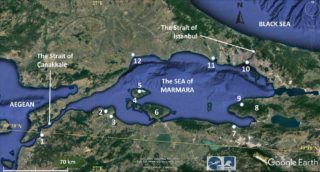
Meanwhile, some new sightings have emerged in the last decade. A few monk seal sightings of single individuals near Esenköy on the Armutlu Peninsula and near Büyükçekmece, west of Istanbul, were made in December 2007 and January 2008 respectively, supported by several photos taken by the observers. The former sighting was reported in TMG in 2008. SAD-AFAG visited the southern coasts of the Sea of Marmara all the way from Mudanya to Karabiga in June of 2008 and collected a set of key information on the wild coastal habitats and the biodiversity of the area (Kıraç, 2008). Based on this survey, we come to the conclusion that monk seals mainly live in and around the Kapıdağ Peninsula, the Marmara Islands Archipelagos and Karabiga.
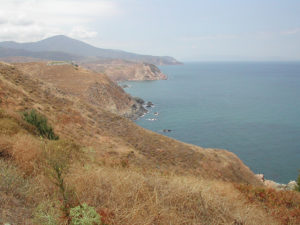
Another new sighting of a monk seal near Karabiga, located on the south-western coast of the Sea of Marmara, supported by a short footage of a swimming seal taken by a local fisherman, was published by İnanmaz et al. (2014). Meanwhile, the 15 km long relatively unspoilt coast of Karabiga (between Karabiga and Şahmelek) was in great danger of habitat destruction due to four different coal thermal power plant (CTPP) projects. Therefore, SAD-AFAG undertook a series of field research studies from September 2014 to April 2018 in the Karabiga region. Field research was conducted in 8 separate sessions in this period, including coastal cave checks by dives, use of IR camera traps in caves and observations from land as well as comprehensive interviews with the local people and the artisanal fishermen in and around Karabiga town.
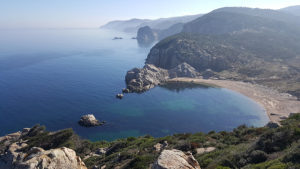
Apart from deploying IR camera traps in caves, researchers carried out observations from selected clifftop points. Both techniques yielded good results and the presence of monk seals was confirmed in this way. First results were obtained from in-cave camera traps in 2014. And then, an adult female monk seal was observed in Karabiga near the Karaburun lighthouse on 20 February 2015 by SAD-AFAG researchers and documented by still pictures and video from a clifftop. This is the first time in the history of monk seal research that a monk seal was recorded directly by dedicated researchers in the Sea of Marmara. The individual was identified and named Özgecan (see Fig-3). Monk seals were also recorded on camera on several different occasions inside the caves along the Karabiga coast using camera traps throughout the seasons from February 2015 until April 2018. All the data on the presence of monk seals in our hand showed only single monk seal sightings in each observation or recording. In March 2018, however, the camera traps deployed by SAD-AFAG recorded two monk seals together inside a cave along the coastal strip between Karabiga and Şahmelek. The camera traps captured photos and videos. A short documentary film shows SAD-AFAG’s field research and findings in search of monk seals as well as our struggle against the threat of potential habitat destruction. The observation of a monk seal swimming close to the coast and the camera video recording of the two monk seals together in a cave near Karabiga are included in this short documentary https://vimeo.com/287651437/c12d1a39fe. The main reason for SAD-AFAG to concentrate on monk seal research in the Sea of Marmara in 2014 was the potential habitat destruction by some coal thermal power plant projects in Karabiga, one of the key coastal stretches of this sea.
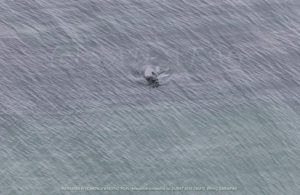
There is a great argument and dispute among energy investors, the Ministry of Environment and local & national scale NGOs on the issue of site selection for CTPP constructions. Although the EIA (Environmental Impact Assessment) reports have been rejected by the courts several times, another field study or Ecosystem Assessment Report to be conducted by an academic team from Çanakkale Onsekiz Mart University (ÇOMÜ) was ordered in 2017 and was completed later in the year. The local NGO platform in Çanakkale called “Kazdağı Environment Platform” applied to the Court against the Ecosystem Assessment Report on the ground that said ÇOMÜ academics provided wrong and misleading information in their reports, stating that monk seals do not live in the area, although it has been clearly proven that the species survives along the coasts in question. Of course, such a report supports the application of energy companies who already applied or have been seeking approval from the Ministry for starting constructions, since the “reported” absence of monk seals will clear the way for the approval of power plant constructions. According to our assessment, those academics or so called “experts” who prepared and signed such fraudulent reports clearly were misleading and cheating both the relevant Ministries and other governmental authorities as well as the whole Turkish public.
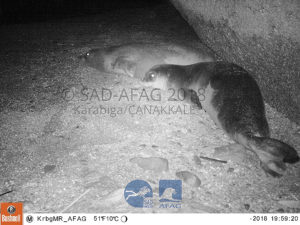
In the beginning of 2018, ÇOMÜ had to start an investigation on the “expert team” composed of five ÇOMÜ members, based on a court application made by Kazdağı Environment Platform. While ÇOMÜ has been carrying out this investigation, it invited SAD-AFAG members working in the field and also two local fishermen, who have actually seen and photographed monk seals near Karabiga, to give testimonial statements on the true observations of the monk seal. C.O. Kıraç and N.O. Veryeri participated in the commission meeting in February 2018 at ÇOMÜ in Çanakkale for the investigation and provided hundreds of monk seal photos and videos taken by SAD-AFAG to the authorities together with their written sworn statements. Ö. E. İnanmaz from Çanakkale also participated and supported our views in the investigation. Later on, the two fishermen made their sworn statements to the ÇOMÜ Investigation Board, stating similar views as SAD-AFAG and submitting their videos and photos taken on the coast of Karabiga, SW Sea of Marmara. The result of the investigation has not been announced yet by ÇOMÜ.
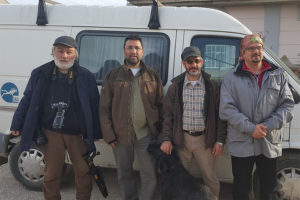
Conclusion
With the new sightings and the recording of two monk seals together in a cave our expectations on the population of the species in the Sea of Marmara were exceeded. The southern coasts of the Sea of Marmara offer suitable habitat for monk seals and the species is present in this closed sea more than expected. The remaining pristine coastal segment between Karabiga and Şahmelek is protected and continues to stay as seen in Fig-2. CCTPs have not been constructed mainly due to the arguments and advocacy put forward by the local NGOs in Çanakkale and Karabiga and SAD-AFAG from 2013 to 2018. Wrong and misleading reports issued by some academics are the major obstacle for conserving marine and coastal Key Biodiversity Areas (KBAs) in the country. Unfortunately, this becomes an epidemic threat nowadays in Turkey. To mitigate the problem, the Underwater Research Society SAD completed a habitat protection project called “DEFENCE KBA Turkey” and an “NGO Capacity Increase” program encouraging local people to get involved in the decision making processes and the monitoring of KBAs in their areas in between 2015 and 2017.
References:
Berkes, F., H. Anat, M. Esenel and M. Kışlalıoğlu. 1979. Distribution and Ecology of Monachus monachus on Turkish Coasts. The Mediterranean Monk Seal Working Paper No.10. in: K. Ronald & R.
Duguy, eds. First International Conference on the Mediterranean Monk Seal, Rhodes, Greece, 1978. Pergamon Press. Oxford, U.K.: 113-127.
Güçlüsoy, H., C.O. Kıraç, Y. Savaş and N.O. Veryeri. 2004. Status of the Mediterranean Monk Seal Monachus monachus (Hermann, 1779) in the Coastal Waters of Turkey. Ege University Journal of Fisheries & Aquatic Sciences 2004. Cilt/Volume 21 Sayı (3-4): 201-210. İzmir, 2004.
İnanmaz, Ö.E., Değirmenci Ö. and Gücü, A.C. 2014. A new sighting of the Mediterranean Monk Seal, Monachus monachus (Hermann, 1779) in the Marmara Sea (Turkey). Zoology in the Middle East. Vol. 60, No. 3. 278-280.
Kıraç, C.O. 2008. Marmara Denizi ve Kıyıları Hala Yaşıyor. Yeşiliz Magazin No:12. Kasım-Aralık 2008. s. 42-45 English Translation.
Kıraç, C.O. and H. Güçlüsoy. Rare Sightings in the Sea of Marmara. Mediterranean News/Turkey in The Monachus Guardian Vol. (11) 1: June 2008.
Kıraç, C.O ve Veryeri, N.O. 2016. Güneybatı Marmara Denizi ve Karabiga Kıyılarında (Biga, Çanakkale) Biyolojik Çeşitlilik ve Deniz-Kıyı Habitatları Araştırma Sonuç Raporu. SAD Yayını. Nisan 2016. Ankara. 45 Sayfa + Ek. (SAD Report Submitted to the Ministry of Forest and Waterworks in Turkish) PDF.
Mursaloğlu, B. 1964. Occurence of the Monk Seal on the Turkish Coasts. Journal of Mammalogy. Vol. 45, No.2, 20 May 1964. Baltimore. pp.316-317.
Savaş, Y. ve C.O. Kıraç. 1992. ODTÜ Sualtı Topluluğu Akdeniz Foku Araştırma Grubu 1992 Yılı Faaliyet Raporu. Ulusal Fok Komitesi’ne Sunulan Rapor. ODTÜ-SAT/AFAG, 25 Aralık 1992. Ankara. (Unpublished Report in Turkish).
